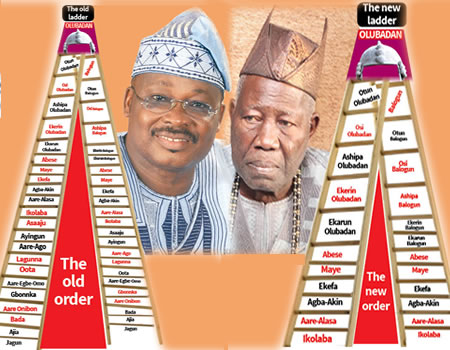
Every family and clan in Ibadanland has a Mogaji. Mogajis are family heads. They control the affairs of their families and ensure law and order. They are made Mogajis by the Olubadan, after they had been so appointed and the family has written to formally inform the Olubadan and the Council. If there are no disputes after the nomination, the Olubadan will approve such nominee to become the Mogaji of the family.
The Oyo State government, in accordance with the Justice Akintunde Boade Commission’s recommendation, has put a hold on new appointment to fill any vacancy in both Otun Olubadan and Balogun lines until the incumbent Jagun on each of the two lines has got promoted to Aare-Alasa on both lines, a step higher than Ikolaba. This is to create a vacancy on the Ikolaba step, which is now the entry point to the ladder.
The development means that all Mogajis who have hitherto not been promoted to the two lines will have to wait until there is vacancy at the Ikolaba entry point. Meanwhile, those currently holding the 11 scrapped positions will still have to be duly promoted upon the death of any of the aspirant on either of the lines.
For now, the ceremonies at the palace may reduce, except for installation of new Mogajis or the promotion of those already on the line. Mogaji Salawu Areokuta told Saturday Tribune that promotion from Mogaji to Jagun used to be very competitive and it was the prerogative of the Olubadan to install whoever he wanted. He said all the Mogajis would now have to wait until there is vacancy at the Ikolaba entry point before such competition would begin again. He, however, said shortening the rungs of the ladder is a good development.
Ibadan is unique for so many things, including the ascension to the throne of its king, the Olubadan. The city has a widely acclaimed republican system of Obaship and succession had always been without rancour. Founded in the 16th century, its present people only took control around 1820. By 1850, they had established an unusual succession principle, which is quite different compared with other traditional Yoruba rulership in that it alternates between two lines, the Otun Olubadan line and the Balogun line. In Ibadan, any male born title-holder of the metropolitan is a potential king.
There are over 200 Mogajis or family heads in Ibadan at present. The installation of Mogajis is often performed at the palace of the Olubadan with pomp and fanfare. Every Mogaji is an Olubadan in waiting if he eventually succeeds to join the ladder. It used to take a whole lot for a Mogaji to become Jagun, the lowest rung of the old Olubadan ladder, as there are competitions from others. It is succinct to note here, however, that once he emerges as Mogaji, no other is such appointed in the family until his eventual demise. The Olubadan, members of the Olubadan-in Council and others on the Olubadan/Balogun lines remain Mogajis of their clans, irrespective of their present status. There cannot be two Mogajis in a family.
Nowadays, Mogajis are preferred to be younger, because of the long road to the throne. The family heads are not necessarily the oldest in their extended family clan, but they are chosen to represent their families. In the words of the current Olubadan of Ibadanland, who is also the Mogaji of his family, Oba Saliu Adetunji, “I became Mogaji in 1976. In 1978, I became Jagun Balogun.” He eventually became Olubadan in 2016 after 38 years on the ladder. It took the late Olubadan Yunusa Bankole Ogundipe a total of 35 years from being Jagun Balogun in 1964 before emerging the Olubadan in 1999. The late Oba (Dr) Samuel Odulana became Jagun Olubadan in 1972, he eventually became the Olubadan in 2007 after 35 years.
To become Jagun, however, the Baale of Ekotedo, Dr Taye Ayorinde, said there were three things to consider. A prospective candidate could be from an historical Ibadan warrior family or must have done valiantly to save the land in one form or another. The candidate might also have done something worthwhile for his community or Ibadanland as a whole, while his wealth, which he must have used for the uplift of the downtrodden, could be another consideration.
Also, the Mogaji of Areokuta family of Oja’gbo in Ibadan, Honourable Ajibola Salawu Areokuta, said becoming Jagun was the tedious of all Ibadan titles. It was the only stage where competitions were keen. According to him, the decision lay with the Olubadan, who is the prescribed and consenting authority.
Out of the over 200 Mogajis records say are in Ibadanland as present, when there is vacancy for the entry-point position, the Olubadan at Council would consider the prospective candidates and thereby appoint one to the Olubadan line and or another to the Balogun line, depending on where the vacancy exists.
The promotion will now follow a sequential and orderly procedure on the Olubadan ladder. Upon vacancy in any of the lines, the title holder of a lower rung is promoted to the next rung. Until the recent review, the Balogun’s line had 23 rungs while the Olubadan line had 22 rungs. The succession to the Olubadan stool alternates between the Balogun and the Otun Olubadan lines.
Before the set-up of the Justice Boade (retd) panel that reviewed the 1959 Olubadan Chieftaincy Declaration, the promotion in the line of Balogun followed this pattern: From Jagun – Ajia – Bada – Are-Onibon – Gbonnka – Aare Egbe Omo – Oota – Lagunna – Are-Ago – Ayingun – Asaju – Ikolaba – Aare-Alasa – Agba-Akin – Ekefa – Maye –Abese – Ekarun Balogun – Ekerin Balogun – Ashipa Balogun – Osi Balogun – Otun Balogun and eventually to Balogun. The journey from Jagun to Balogun will take a prospective candidate through a 23-rung ladder. Having reached the top, he becomes Balogun and would, therefore, wait for his turn to emerge the Olubadan of Ibadanland.
The promotion in the line of Olubadan followed the same pattern, but there were 22 rungs: From Jagun – Ajia – Bada – Aare Onibon – Gbonnka – Aare-Egbe Omo – Oota – Lagunna – Are-Ago – Ayingun – Asaju – Ikolaba – Aare-Alasa – Agba-Akin – Ekefa – Maye – Abese – Ekarun Olubadan – Ekerin Olubadan – Ashipa Olubadan – Osi Olubadan and finally to Otun Olubadan. The nomenclature looks the same with that of Balogun until when the prospective candidate finally gets to the Ekarun Olubadan. Upon emergence as the Otun Olubadan, the candidate is set to emerge the next Olubadan of Ibadanland on his turn.
Baale Ayorinde gave the English meaning of some of the titles thus:
Otun – second in command/Commander of the right wing; Osi – third in command/Commander of the left wing; Asipa – Leader of the Vanguard; Ekerin – Fourth in Command; Ekarun – Fifth in Command; Abese – Superintendent of foot soldiers; Maye – Stationary Veteran Soldiers; Ekefa – Sixth in command; Agba-Akin – Chief of the Brave; Aare-Alasa – Chief of the Squire; Ikolaba – Sango’s apron man; Asaaju – Front ranker (front liner); Ayingun – Official war wager; Aare-Ago – Overseer of Blood Relations; Laguna – Swivel Lance Comptroller General; Oota – Sharp Shooter; Aare-Egbe-Omo – General of the Youth Wing; Gbonka – Dignified war wager; Aare-Onibon – Brigadier-General of Gun Combatant Shooter; Bada – Chief Spy; Ajia – Commissioner and Jagun – Warrior/Defender of the ruler.
A critical look at the ladder used for this illustration shows the upward movement of a particular candidate for the stool of Olubadan on either line of Balogun or Otun Olubadan. Such candidates continue to rise upon the death of a member on the line. If death occurs of any member on the ladder, there has to be an installation ceremony to the next rank for affected candidates not less than 21 days after the burial of the last occupant.
The Olubadan, upon notification of such death, will approve the promotion of others and perform installation ceremonies at his palace. This is one of the reasons Ibadan chiefs are called Agbotikuyo (someone who rejoices at the death of another aspirant). Death of a member means promotion for another!
To shorten the length of the ladder and the time it takes to become an Olubadan of Ibadanland, the Oyo State government, in a White Paper on the Review of the Existing Olubadan of Ibadanland Chieftaincy Declaration, published in a Government Gazette Notice No 27, No 14, Vol.42 of August 22, 2017 and signed by the Secretary to the State Government, Alhaji Olalekan Alli, has reduced the length of the ladder to 11 steps on the Otun Olubadan line and 12 steps on the Balogun line.
As against the Jagun entry point to both lines, the government approved that each line should now start from Ikolaba. Eleven positions were scrapped from both lines. The scrapped positions were Ajia, Bada, Aare Onibon, Gbonnka, Aare-Egbe Omo, Oota, Lagunna, Are-Ago, Ayingun and Asaju. The steps now reduced to Ikolaba – Aare-Alasa – Agba-Akin – Ekefa – Maye – Abese – Ekarun Olubadan – Ekerin Olubadan – Ashipa Olubadan – Osi Olubadan and finally to Otun Olubadan for the Otun Olubadan line and Ikolaba – Aare-Alasa – Agba-Akin – Ekefa – Maye –Abese – Ekarun Balogun – Ekerin Balogun – Ashipa Balogun – Osi Balogun – Otun Balogun and eventually to Balogun for the Balogun line.
WATCH TOP VIDEOS FROM NIGERIAN TRIBUNE TV
- Relationship Hangout: Public vs Private Proposals – Which Truly Wins in Love?
- “No” Is a Complete Sentence: Why You Should Stop Feeling Guilty
- Relationship Hangout: Friendship Talk 2025 – How to Be a Good Friend & Big Questions on Friendship
- Police Overpower Armed Robbers in Ibadan After Fierce Struggle





